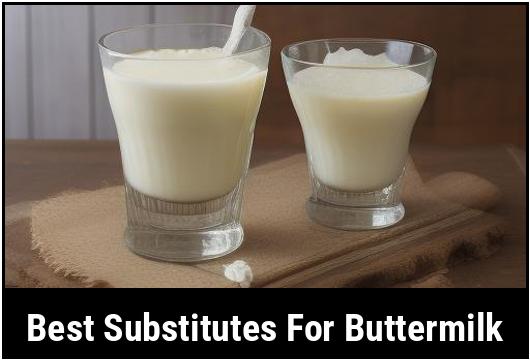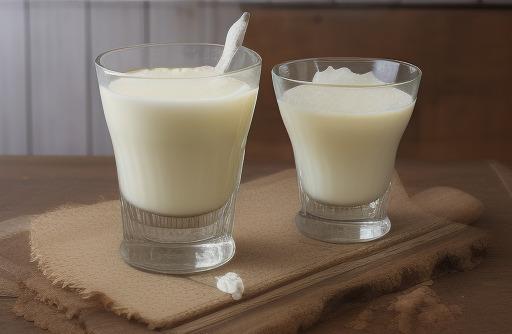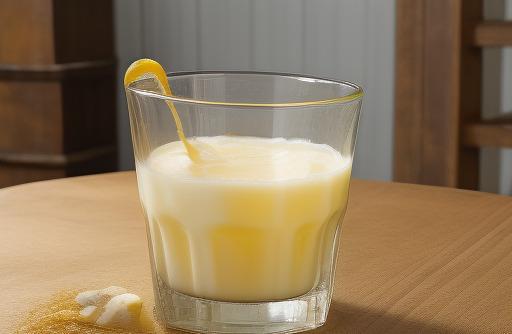- You are here:
- Home »
- Food Substitutes
- » Best Substitutes For Buttermilk
Best Substitutes For Buttermilk

Buttermilk is a versatile ingredient that adds richness and tanginess to a wide variety of dishes. It is commonly used in baking, marinades, salad dressings, and even fried chicken recipes. However, there may be times when you run out of buttermilk or simply don’t have it on hand. In such situations, it’s good to know that there are several substitutes that can mimic the taste and texture of buttermilk. In this article, we will explore the best substitutes for buttermilk, how to choose the right one, and how to cook with them.
Key Takeaways
- Buttermilk is a versatile ingredient used in baking, marinades, dressings, and more.
- Substitutes for buttermilk include milk and acid, yogurt, sour cream, kefir, or a homemade buttermilk substitute.
- Choosing the right substitute depends on the dish you are preparing and the desired taste and texture.
- When cooking with substitutes for buttermilk, adjust the recipe accordingly to account for differences in consistency and taste.
Why You Need A Substitute For Buttermilk
There are several reasons why you might need a substitute for buttermilk. First and foremost, it may simply be because you’ve run out of it and don’t have time to make a trip to the grocery store. Additionally, some people may opt for a substitute due to dietary restrictions or personal preferences. For example, those with lactose intolerance might prefer to use a non-dairy substitute like almond or soy milk. Lastly, using a substitute can also be a way to add a unique flavor or texture to a dish, giving it a twist.
Types Of Substitutes For Buttermilk

There are several types of substitutes for buttermilk that you can use in your cooking and baking. Here are the most common options:
-
Milk and Acid: This is the easiest and most accessible substitute. Simply combine one cup of milk with one tablespoon of acid, such as lemon juice or vinegar. Let it sit for about 5 minutes to allow the milk to sour and thicken. This mixture will mimic the tanginess of buttermilk.
-
Yogurt: Yogurt is another excellent substitute for buttermilk. Simply use plain yogurt in the same quantity as the buttermilk called for in the recipe. The consistency of yogurt is similar to buttermilk, and it also adds a tangy flavor to the dish.
-
Sour Cream: If you have some sour cream on hand, it can be a great alternative to buttermilk. Use the same amount of sour cream as you would buttermilk in the recipe. Sour cream adds creaminess and tanginess to the dishes.
-
Kefir: Kefir is a fermented milk drink that has a thick consistency and tangy flavor, similar to buttermilk. Use kefir in a 1:1 ratio as a substitute for buttermilk. It not only adds a tangy taste but also provides probiotics.
-
Homemade Buttermilk Substitute: If you don’t have any of the above ingredients, you can make a homemade buttermilk substitute. To make one cup of buttermilk substitute, combine one cup of milk with one tablespoon of lemon juice or vinegar. Let it sit for 5-10 minutes until it thickens and curdles slightly.
Best Substitutes For Buttermilk

Now that we know the different types of substitutes, let’s look at which ones are considered the best alternatives to buttermilk:
-
Milk and Acid: This is the most common and widely used substitute for buttermilk. The combination of milk and acid mimics the tanginess of buttermilk and can be used in a variety of recipes. It is an ideal substitute in baking cakes, muffins, and biscuits. However, keep in mind that the texture might not be as thick as traditional buttermilk.
-
Yogurt: Yogurt is a versatile substitute that can be used in both sweet and savory recipes. It provides a tangy taste and helps to keep baked goods moist and tender. Yogurt is especially great for making salad dressings, marinades, and creamy sauces. Choose plain yogurt without any flavors or additives to ensure the closest resemblance to buttermilk.
-
Sour Cream: Sour cream is an excellent substitute for buttermilk in recipes that require a creamy and tangy flavor. It works well in both sweet and savory dishes, such as pancakes, waffles, and dressings. Keep in mind that sour cream has a thicker consistency than buttermilk, so you may need to thin it out with a little water to achieve the desired texture.
-
Kefir: Kefir is an excellent substitute for buttermilk, especially in recipes that call for a tangy flavor. It has a similar consistency to buttermilk and provides the same tanginess. Kefir is a great option for making smoothies, pancakes, and other baked goods. It also adds a boost of probiotics to your dish.
-
Homemade Buttermilk Substitute: If you don’t have any of the other substitutes available, you can easily make a homemade buttermilk substitute using milk and acid. This substitute works well in most recipes that call for buttermilk, although the texture may vary slightly. It is a great option for baking, marinades, and dressings.
Choosing The Right Substitute For Buttermilk

When choosing the right substitute for buttermilk, it’s important to consider the specific dish you are preparing and the desired taste and texture. Here are a few tips to help you choose the best substitute:
-
For baking: If you are using buttermilk in a baking recipe, such as cakes, muffins, or biscuits, the milk and acid substitute or yogurt are the best options. They provide the necessary tanginess and acidity to help activate baking soda or powder and contribute to a moist and tender texture.
-
For dressings and marinades: When making dressings or marinades, sour cream or yogurt can be excellent substitutes. They add a creamy and tangy flavor, giving your dish a delicious twist. You can also use kefir if you want to enhance the tangy taste.
-
For savory dishes: In savory dishes like pancakes, fried chicken, or crispy fish, you can use either the milk and acid substitute or the sour cream substitute. Both will provide a tangy flavor and help to tenderize meat or create a crispy coating.
-
For a dairy-free option: If you are lactose intolerant or following a dairy-free diet, consider using a non-dairy milk substitute, such as almond milk or soy milk, combined with acid. The taste and texture may differ slightly, so adjust the recipe as needed.
Cooking With Substitutes For Buttermilk

Once you have chosen the right substitute for buttermilk, it’s important to know how to cook with it. Here are a few tips and tricks to ensure success:
-
Adjust the consistency: Keep in mind that substitutes may have different consistencies than buttermilk. If the recipe calls for a thicker batter or dough, you may need to add a little extra flour or reduce the amount of substitute to achieve the desired texture.
-
Adjust the taste: While substitutes for buttermilk can mimic the tanginess of buttermilk, they may have a slightly different flavor profile. Taste the batter or mixture before proceeding with the recipe and adjust the seasonings or other flavors as needed.
-
Add an emulsifier: If you are using a substitute that is thinner than buttermilk, such as the milk and acid substitute, you can add a small amount of oil, melted butter, or an emulsifying agent like mayonnaise or mustard to help emulsify the ingredients and create a creamy texture.
-
Increase leavening agents: Buttermilk helps to activate leavening agents like baking soda or baking powder. If you are using a substitute for buttermilk, you may need to increase the amount of these leavening agents slightly to ensure proper rising.
-
Marinating meat: If you are using a substitute for buttermilk as a marinade for meat, make sure to let it sit for at least 30 minutes to allow the flavors to penetrate. The acidic nature of the substitute will help to tenderize the meat and add flavor.
-
Experiment: Cooking is all about experimenting and finding what works best for you. Don’t be afraid to try different substitutes and adjust the recipe to your liking. You may discover a unique flavor or texture that you prefer over traditional buttermilk.
Pro Tip: If you are using a non-dairy substitute, such as almond milk or soy milk, make sure to choose an unsweetened variety. The added sugar in sweetened versions can alter the taste and texture of your dish.
Recipes Using Substitutes For Buttermilk

Here are a few recipes that you can try using substitutes for buttermilk:
-
Fluffy Pancakes: For light and fluffy pancakes, use the milk and acid substitute or yogurt instead of buttermilk. Adjust the batter consistency as needed to achieve the desired texture. Serve with your favorite toppings like syrup, fresh fruits, or whipped cream.
-
Tangy Dressing: In a small bowl, whisk together sour cream, lemon juice, Dijon mustard, minced garlic, salt, and pepper to taste. Drizzle the tangy dressing over your favorite salads or use it as a dip for fresh vegetables.
-
Buttermilk Fried Chicken: Marinate chicken pieces in a mixture of milk and acid or yogurt with spices like paprika, garlic powder, and cayenne pepper. Let it sit in the marinade for at least 30 minutes before coating the chicken with flour and frying until crispy and golden brown.
-
Tender Biscuits: Substitute buttermilk with the milk and acid mixture or yogurt in your favorite biscuit recipe. The tanginess will contribute to a tender texture and add a subtle tang to the biscuits.
-
Creamy Pasta Sauce: In a saucepan, combine sour cream with sautéed garlic, grated Parmesan cheese, and a splash of lemon juice. Cook over low heat until warm and creamy. Toss the sauce with cooked pasta and your choice of vegetables or protein for a delicious and creamy pasta dish.
Storage And Shelf Life Of Substitutes
Substitutes for buttermilk, such as the milk and acid mixture, yogurt, sour cream, and kefir, can usually be stored in the refrigerator for up to one week. However, keep in mind that their consistency and taste may change over time. Homemade buttermilk substitute, on the other hand, should be used immediately or stored in an airtight container in the refrigerator for no more than 24 hours.
When using substitutes for buttermilk in recipes that require longer cooking times, such as soups or stews, the taste and texture will often mellow and blend with other ingredients during the cooking process. Therefore, you may not notice a significant difference in the final dish.
Conclusion
While buttermilk is a staple in many kitchens, there are several excellent substitutes that can be used in a pinch or to add different flavors and textures to your dishes. Whether you choose to use milk and acid, yogurt, sour cream, kefir, or a homemade buttermilk substitute, each option brings its own unique qualities to the recipe. By understanding the characteristics of each substitute and adjusting the recipe accordingly, you can successfully cook and bake without traditional buttermilk. So, don’t let a lack of buttermilk hold you back from creating delicious and flavorful dishes!
FAQS
What Is The Best Alternative For Buttermilk In Baking?
One of the best substitutes for buttermilk in baking is sour milk. You can make sour milk by adding one tablespoon of vinegar or lemon juice to regular milk and letting it sit for 5-10 minutes. Another great option is plain yogurt, which has a similar tangy flavor and thickness to buttermilk.
Can I Use Milk As A Substitute For Buttermilk In Recipes?
Yes, you can use regular milk as a substitute for buttermilk. To do so, simply add one tablespoon of vinegar or lemon juice to one cup of milk and let it sit for a few minutes until it curdles. You can then use this mixture as you would buttermilk in your recipe.
Are There Any Non-dairy Alternatives To Buttermilk?
Yes, there are several non-dairy alternatives to buttermilk. One option is to use a mixture of non-dairy milk (such as almond or soy milk) and vinegar or lemon juice to make a buttermilk substitute. Another option is to use a non-dairy yogurt, such as coconut or soy yogurt, in place of buttermilk in recipes.
Can I Use Cream As A Substitute For Buttermilk?
While cream is not a direct substitute for buttermilk, you can use it to create a similar texture and tangy flavor in recipes. To do so, mix one tablespoon of vinegar or lemon juice with one cup of cream and let it sit for a few minutes until it thickens slightly. You can then use this mixture as you would buttermilk in your recipe.
What Other Ingredients Can I Use To Replace Buttermilk In Recipes?
In addition to the options mentioned above, there are several other ingredients you can use to replace buttermilk in recipes. These include kefir, which has a similar texture and tangy flavor to buttermilk, as well as apple cider vinegar, which can be used to create a buttermilk substitute when combined with regular milk. Additionally, some recipes may work well with a simple mixture of water and lemon juice or vinegar as a substitute for buttermilk.
Sources
About the Author Jenny
I'm Jenny, a housewife with an unwavering passion for food. My culinary journey began with my grandmother's kitchen, and it's now a full-fledged food blog. I've turned my love for cooking into a creative outlet, sharing recipes and stories with a global community of fellow food enthusiasts. It's proof that being a housewife can also mean pursuing your passions and savoring life's delectable moments.
